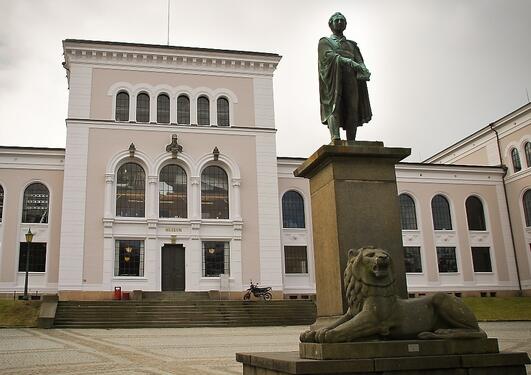Millions granted to humanities research
Professor Scott Rettberg and associate professor Ingrid Halland receive 12 million each from the Research Council of Norway for projects at the intersection between technology and aesthetics.

Main content
Researchers at the Department of Linguistic, Literary and Aesthetic Studies nearly hit a grand slam in the competition for this year’s SAMKUL funding, winning two out of three of the grants approved nationally.
Professor of Digital Culture Scott Rettberg and associate professor of Art History Ingrid Halland receive NOK 12 million each. Both projects will in different manners look at connections between technology and aesthetics.
"Scott has been here for many years and has been awarded several projects over the years, while Ingrid is newly employed and just hits from the start. This is great, they have done a brilliant job! I am very proud of two highly skilled employees," says head of the department, Anders Fagerjord.
"It is also very gratifying that we are doing well in a programme where the societal relevance of research is so central. This shows that our research is innovative and relevant. Both projects have a strong contemporary dimension and stem from the researchers' core interests. The fact that we are doing this strongly here, also shows that we are good at interdisciplinary research," he says.
Narrative applications of new technologies
"This feels fantastic. I’ve been working on developing and refining this proposal for the better part of three years. It had very good scores the past two years, so it is wonderful to see the work pay off. It is humbling to be among the few research projects that are supported," says Rettberg.
The funded project Extending Digital Narratives is essentially about the narrative applications of three newer technologies: XR (virtual reality and augmented reality systems), generative systems that use AI and other algorithms to author narratives, and conversational interfaces such as smart speakers. The research team want to better understand how these emerging technologies will impact the ways that we tell stories and interact with each other in the social sphere.
"We want to map, document, and analyze the most important narrative work that has been done with these technologies and conduct experimental research with writers and artists who are producing creative work. It may sound bold, but we plan to advance the cultural applications of these technologies through both analysis and creative practice," Rettberg says, and elaborates:
"Algorithmic narrativity – the ways that humans interact with computers, networks, and metainterfaces that shape narrative, is currently having a profound impact on our culture and everyday lives. This project will help us to advance our understanding of that and will open up new applications of humanities research."
The majority of Rettbergs research group, Bergen Electronic Literature, will be involved in this project. They will also be working with researchers in the Department of Foreign Language and the Department of Fine Arts at the University of Bergen. They are further working with international partners including the Digital Storytelling Lab at York University and the Electronic Visualization Lab at the University of Illinois Chicago. The project will also support a PhD and a postdoc researcher working with their team.
Technological innovation has made the world whiter
Halland's project How Norway Made the World Whiter is the first large-scale research project that will connect the challenging topics: whiteness, technological innovation, and mass-exploitation of natural resources in a single case study.
"The grant is important not only for me and my research group, but for my entire field of study. This shows that art history, aesthetic theory and artistic research are an entry point to understanding complex questions about society, politics and technology," Halland says.
Her research team will explore how the Norwegian innovation titanium white has changed surfaces in art, architecture and design – something that has made the world look whiter, brighter, and superficially cleaner.
The project will do this through an interdisciplinary research design grounded in an original and creative humanities approach that merges art history and artistic research. They will study the Norwegian innovations the chemical compound titanium dioxide and the white pigment titanium white in a historical, aesthetic, and critical lens – focusing on how the innovations transformed surfaces in art, architecture, and design – in order to show how aesthetic transformation is driven by technological development.
"The overall objective of the project is to critically investigate the cultural and aesthetic preconditions of a complex and unexplored part of Norwegian technology and innovation history that has – as this project boldly claims – made the world whiter," Halland says.
The project has two parts, an academic part and an artistic part. Halland and her collaborators are attempting ground-breaking work where artistic research and art history are brought together in new ways.
"With this project, we also show how Norwegian universities, art institutions and museums can collaborate on research. We have a large project group and many collaborative partners. The core group consists of myself (UiB/AHO) and Marte Johnslien (KHiO), with partners from Aarhus University, UiB, the mining company Titania AS, Østfoldmuseene, Dalane Folkemuseum, Jøssingfjord Science Museum, the Norwegian Museum of Mining, and the art institutions Kraft and ROM for kunst og arkitektur," says Halland.
By weaving together historical, critical, aesthetic, and artistic methods with public engagement and outreach, the project reveals a complex and challenging story of how a local Norwegian innovation came to have planetary consequences.
